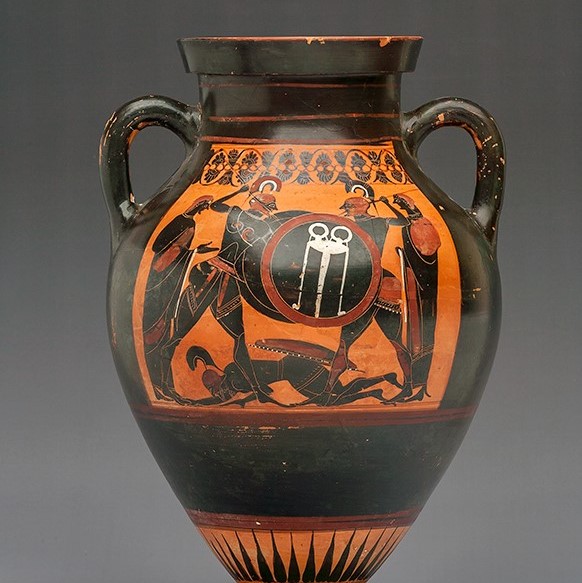
Artefact or object:
Description:
Attic Black-Figure Pottery
Introduction by J.R. Green
Attic black-figure has the decoration in black silhouette, with the inner details shown by incision and some features enlivened with added white and purple-red. The style arose at the end of the seventh century, and in its earliest stages concentrated on large powerful figures (cf. the olpe 1976.07) which are in contrast with most Corinthian which preferred a small scale. From ca 580-570 BC a miniaturist tendency set in for some categories of material, a tendency which found its fruition in the series of Little Master cups (see these elsewhere in this catalogue) of the middle of the century. By the third quarter of the sixth century, larger scale work had begun to benefit from the miniaturist trend with the result that figures were more carefully controlled in style, expression and pose; this is the period at which black-figure reached its height with masters such as Exekias and the Amasis Painter. In the next generation, probably about 530-525 BC, the Andokides Painter, a pupil of Exekias, introduced the red-figure technique. For the rest of the century, however, the new technique was applied only to the more important vases and the bulk continued to be made in black-figure. By the fifth century the technique was in decline. It came to be used mostly for small vessels, especially lekythoi destined for the grave. (We may note that the tomb of the Athenian dead at Marathon, 490 BC, contained almost entirely black-figure.) In the first quarter of the fifth century lekythoi were still decorated with figure-scenes, though of repetitive types; towards the middle of the century, they more often have pattern-work (see 1965.04 and 1973.07 and 1973.08).
For serious study, Beazley’s lists of attributed vases in Attic Black-Figure Vase-Painters (Oxford 1956), with additions in Paralipomena: Additions to Attic Black-Figure Vase-Painters and to Attic Red-Figure Vase-Painters (Oxford 1971) and T.H. Carpenter’s Beazley Addenda: Additional References to ABV, ARV2 and Paralipomena (Oxford 1989) are indispensable. For an introduction, Beazley’s Development of Attic Black Figure (revised ed., Berkeley 1986) gives a sympathetic and authoritative treatment. John Boardman’s Athenian Black Figure Vases (London 1974) is a full and handy survey with many illustrations. See also B.A. Sparkes, The Red and the Black. Studies in Greek Pottery (London - New York 1996). On questions of the process of manufacture, see J.V. Noble, The Techniques of Painted Attic Pottery (London 1966) and T. Schreiber, Athenian Vase Construction: A Potter’s Analysis (Malibu 1999).